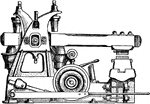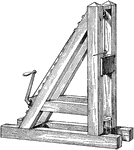Clipart tagged: ‘pile driver’

Horizontal Steam Power Hammer
A trip hammer resembles a hand-hammer held in a horizontal position. The hammer is placed at the end…

Pile Driver
This pile driver is powered by a horse. The horse will pull a cord that raises the weight. When the…

Pile Driver
An illustration of a pile driver which is a machine used to drive piles into the ground which is what…

Vertical Steam Hammer
In 1838, Nasmyth, of England, planned his really great invention — the steam-hammer. His idea…